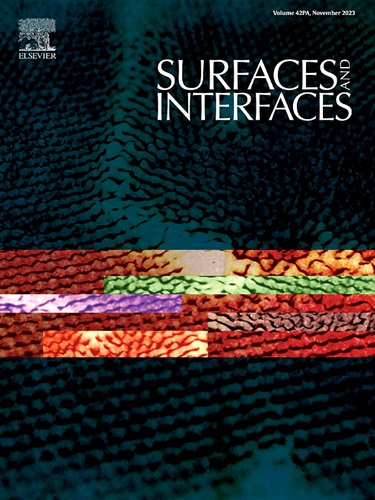Optimizing the resistivity of colloidal SnO2 thin films by ion implantation and annealing
IF 5.7
2区 材料科学
Q2 CHEMISTRY, PHYSICAL
引用次数: 0
Abstract
Tin oxide (SnO2) is a critical material for a wide range of applications, such as in perovskite solar cells, gas sensors, as well as for photocatalysis. For these applications the transparency to visible light, high availability, cheap fabrication process and high conductivity of SnO2 benefits its commercial deployment. In this paper, we demonstrate that the resistivity of widely colloidal SnO2 can be reduced by noble gas ion beam modification. After low energy argon implantation with a fluence of 4×1015 at.cm−2 at 25keV and annealing at 200°C in air, the resistivity of as-deposited film was reduced from (178±6)μΩcm to (133±5)μΩcm, a reduction of 25%. Hall effect measurements showed that the primary cause of this is the increase in carrier concentration from (8.1±0.3)×1020 cm−3 to (9.9±0.3)×1020 cm−3. Annealing at 200°C resulted in the removal of defect clusters introduced by implantation, while annealing at 300°C resulted in the oxidation of the films, increasing their resistivity. The concentration of oxygen vacancy defects can be controlled by a combination of low energy noble gas ion implantation and annealing, providing promising performance increases for potential applications of SnO2 where a low resistivity is crucial.

通过离子注入和退火优化二氧化锡胶体薄膜的电阻率
氧化锡(SnO2)是一种应用广泛的关键材料,如用于过氧化物太阳能电池、气体传感器以及光催化。在这些应用中,二氧化锡对可见光的透明性、高可用性、廉价的制造工艺和高导电性都有利于其商业应用。在本文中,我们证明了通过惰性气体离子束改性可以降低广泛胶体二氧化锡的电阻率。在 25keV 下以 4×1015 at.cm-2 的通量进行低能氩离子注入并在 200°C 的空气中退火后,沉积薄膜的电阻率从 (178±6)μΩcm 降低到 (133±5)μΩcm,降低了 25%。霍尔效应测量结果表明,主要原因是载流子浓度从 (8.1±0.3)×1020 cm-3 增加到 (9.9±0.3)×1020 cm-3。200°C 退火可去除植入过程中引入的缺陷簇,而 300°C 退火则会导致薄膜氧化,增加其电阻率。氧空位缺陷的浓度可通过低能惰性气体离子植入和退火相结合的方法加以控制,从而有望提高对电阻率要求较低的二氧化锡的潜在应用性能。
本文章由计算机程序翻译,如有差异,请以英文原文为准。
求助全文
约1分钟内获得全文
求助全文
来源期刊

Surfaces and Interfaces
Chemistry-General Chemistry
CiteScore
8.50
自引率
6.50%
发文量
753
审稿时长
35 days
期刊介绍:
The aim of the journal is to provide a respectful outlet for ''sound science'' papers in all research areas on surfaces and interfaces. We define sound science papers as papers that describe new and well-executed research, but that do not necessarily provide brand new insights or are merely a description of research results.
Surfaces and Interfaces publishes research papers in all fields of surface science which may not always find the right home on first submission to our Elsevier sister journals (Applied Surface, Surface and Coatings Technology, Thin Solid Films)
 求助内容:
求助内容: 应助结果提醒方式:
应助结果提醒方式:


